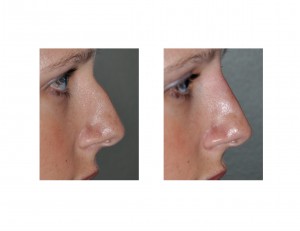Background: The use of injectable fillers has revolutionized the whole approach to facial rejuvenation, particularly for the early aging patient. It is no surprise that their ease of injection and immediate volumetric effects has led to their use for structural facial changes such as chin augmentation. Such use has even been extended to nose reshaping leading to such terms as non-surgical rhinoplasty, injectable rhinoplasty and the 5 minute rhinoplasty.
The concept of the injectable rhinoplasty is, indeed, simple although not necessarily completely painless. By using any one of the available injectable filler options, small volume amounts are selectively placed to increments of nose reshaping by their augmentative effects. Like all injectable fillers, it is quick and easy even in the tissues of the nose where there is little subcutaneous space.
While such injectable rhinoplasties are certainly appealing, how well do they work, who is a good candidate for it and what are the potential risks? Not to be confused with a surgical rhinoplasty, patient selection is crucial when using an injectable technique. Surgical rhinoplasty can change almost every component of the nose, injectable fillers can change very few. Thus injectable fillers can not do what a closed or open rhinoplasty can do, it simply is not a substitute for surgery.
Case Study: This 27 year-old female had a hump on her nose and was going to eventually have a formal surgical rhinoplasty for an overall nose shape change. But that would await until later and she wanted an immediate improvement for now. Her hump was of moderate size and she had a low and well-defined nasofrontal angle.

The one place that injections work well in the nose is the bridge. The skin stretches fairly easily and can accommodate relatively good volumes of injectable material.(.3 to .4ccs) For small to moderate humps or bumps on the nose, filling in above it will make it disappear by creating a straighter dorsal line. In very large humps, however, the amount of injectable material needed will raise the radix area so high that it will look unnatural. (flattening the nasofrontal angle)
Despite the array of available injectable fillers, there is no one filler type that produces a superior result. (at least for the bridge of the nose) The smooth linear flow through a small 30 gauge needle and a long history of few complications makes any of the hyaluronic family of fillers choices. (e.g., Juvederm, Restylane)
Case Highlights:
- The injectable rhinoplasty has limited effectiveness in aesthetic nose reshaping.
- Its best use for a primary nose (one that has never had surgery) is to mask a nasal hump.
- The choice of injectable filler is based on how long one wants the effect to last. All injectable fillers will work for an injectable rhinoplasty.
Dr. Barry Eppley
Indianapolis, Indiana


